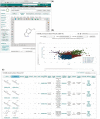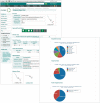ChEMBL: a large-scale bioactivity database for drug discovery
- PMID: 21948594
- PMCID: PMC3245175
- DOI: 10.1093/nar/gkr777
ChEMBL: a large-scale bioactivity database for drug discovery
Abstract
ChEMBL is an Open Data database containing binding, functional and ADMET information for a large number of drug-like bioactive compounds. These data are manually abstracted from the primary published literature on a regular basis, then further curated and standardized to maximize their quality and utility across a wide range of chemical biology and drug-discovery research problems. Currently, the database contains 5.4 million bioactivity measurements for more than 1 million compounds and 5200 protein targets. Access is available through a web-based interface, data downloads and web services at: https://www.ebi.ac.uk/chembldb.
Figures


Similar articles
-
The ChEMBL bioactivity database: an update.Nucleic Acids Res. 2014 Jan;42(Database issue):D1083-90. doi: 10.1093/nar/gkt1031. Epub 2013 Nov 7. Nucleic Acids Res. 2014. PMID: 24214965 Free PMC article.
-
Collation and data-mining of literature bioactivity data for drug discovery.Biochem Soc Trans. 2011 Oct;39(5):1365-70. doi: 10.1042/BST0391365. Biochem Soc Trans. 2011. PMID: 21936816
-
ChEMBL web services: streamlining access to drug discovery data and utilities.Nucleic Acids Res. 2015 Jul 1;43(W1):W612-20. doi: 10.1093/nar/gkv352. Epub 2015 Apr 16. Nucleic Acids Res. 2015. PMID: 25883136 Free PMC article.
-
Using ChEMBL web services for building applications and data processing workflows relevant to drug discovery.Expert Opin Drug Discov. 2017 Aug;12(8):757-767. doi: 10.1080/17460441.2017.1339032. Epub 2017 Jun 12. Expert Opin Drug Discov. 2017. PMID: 28602100 Free PMC article. Review.
-
Making every SAR point count: the development of Chemistry Connect for the large-scale integration of structure and bioactivity data.Drug Discov Today. 2011 Dec;16(23-24):1019-30. doi: 10.1016/j.drudis.2011.10.005. Epub 2011 Oct 14. Drug Discov Today. 2011. PMID: 22024215 Review.
Cited by
-
VirtualTaste: a web server for the prediction of organoleptic properties of chemical compounds.Nucleic Acids Res. 2021 Jul 2;49(W1):W679-W684. doi: 10.1093/nar/gkab292. Nucleic Acids Res. 2021. PMID: 33905509 Free PMC article.
-
Predicting drug metabolism: experiment and/or computation?Nat Rev Drug Discov. 2015 Jun;14(6):387-404. doi: 10.1038/nrd4581. Epub 2015 Apr 24. Nat Rev Drug Discov. 2015. PMID: 25907346 Review.
-
Plant-Based Phytochemicals as Possible Alternative to Antibiotics in Combating Bacterial Drug Resistance.Antibiotics (Basel). 2020 Aug 4;9(8):480. doi: 10.3390/antibiotics9080480. Antibiotics (Basel). 2020. PMID: 32759771 Free PMC article. Review.
-
Repositioning of 8565 Existing Drugs for COVID-19.J Phys Chem Lett. 2020 Jul 2;11(13):5373-5382. doi: 10.1021/acs.jpclett.0c01579. Epub 2020 Jun 23. J Phys Chem Lett. 2020. PMID: 32543196 Free PMC article.
-
In search of novel ligands using a structure-based approach: a case study on the adenosine A2A receptor.J Comput Aided Mol Des. 2016 Oct;30(10):863-874. doi: 10.1007/s10822-016-9963-7. Epub 2016 Sep 15. J Comput Aided Mol Des. 2016. PMID: 27629350 Free PMC article.
References
-
- Paolini GV, Shapland RHB, van Hoorn WP, Mason JS, Hopkins AL. Global mapping of pharmacological space. Nat. Biotechnol. 2006;24:805–815. - PubMed
-
- Mestres J, Gregori-Puigjané E, Valverde S, Solé RV. The topology of drug–target interaction networks: implicit dependence on drug properties and target families. Mol. Biosyst. 2009;5:1051–1057. - PubMed
-
- Wassermann AM, Bajorath J. Large-scale exploration of bioisosteric replacements on the basis of matched molecular pairs. Future Med. Chem. 2011;3:425–436. - PubMed
-
- Papadatos G, Alkarouri M, Gillet VJ, Willett P, Kadirkamanathan V, Luscombe CN, Bravi G, Richmond NJ, Pickett SD, Hussain J, et al. Lead optimization using matched molecular pairs: inclusion of contextual information for enhanced prediction of HERG inhibition, solubility, and lipophilicity. J. Chem. Inf. Model. 2010;50:1872–1886. - PubMed
Publication types
MeSH terms
Substances
Grants and funding
LinkOut - more resources
Full Text Sources
Other Literature Sources
Molecular Biology Databases

